Study Skills Essay: Advantages and Disadvantages of E-learning
VerifiedAdded on 2022/12/27
|8
|2076
|28
Essay
AI Summary
This essay explores the impact of e-learning on higher education, particularly in light of the COVID-19 pandemic. It begins by defining e-learning and its emergence in India, highlighting its rapid adoption by schools and the subsequent increase in demand. The essay then delves into the advantages of e-learning, such as cost reduction, accessibility, and the provision of a comfortable learning environment for students. It also addresses the various tools and techniques used in online learning, like video calls and online assessments. However, the essay also acknowledges the disadvantages, including the lack of face-to-face interaction, technological issues, and potential health hazards associated with prolonged screen time. Furthermore, it discusses the challenges faced by students with different learning styles and the impact on social interaction. The essay concludes by summarizing the overall impact of e-learning and its role in maintaining education during challenging times.
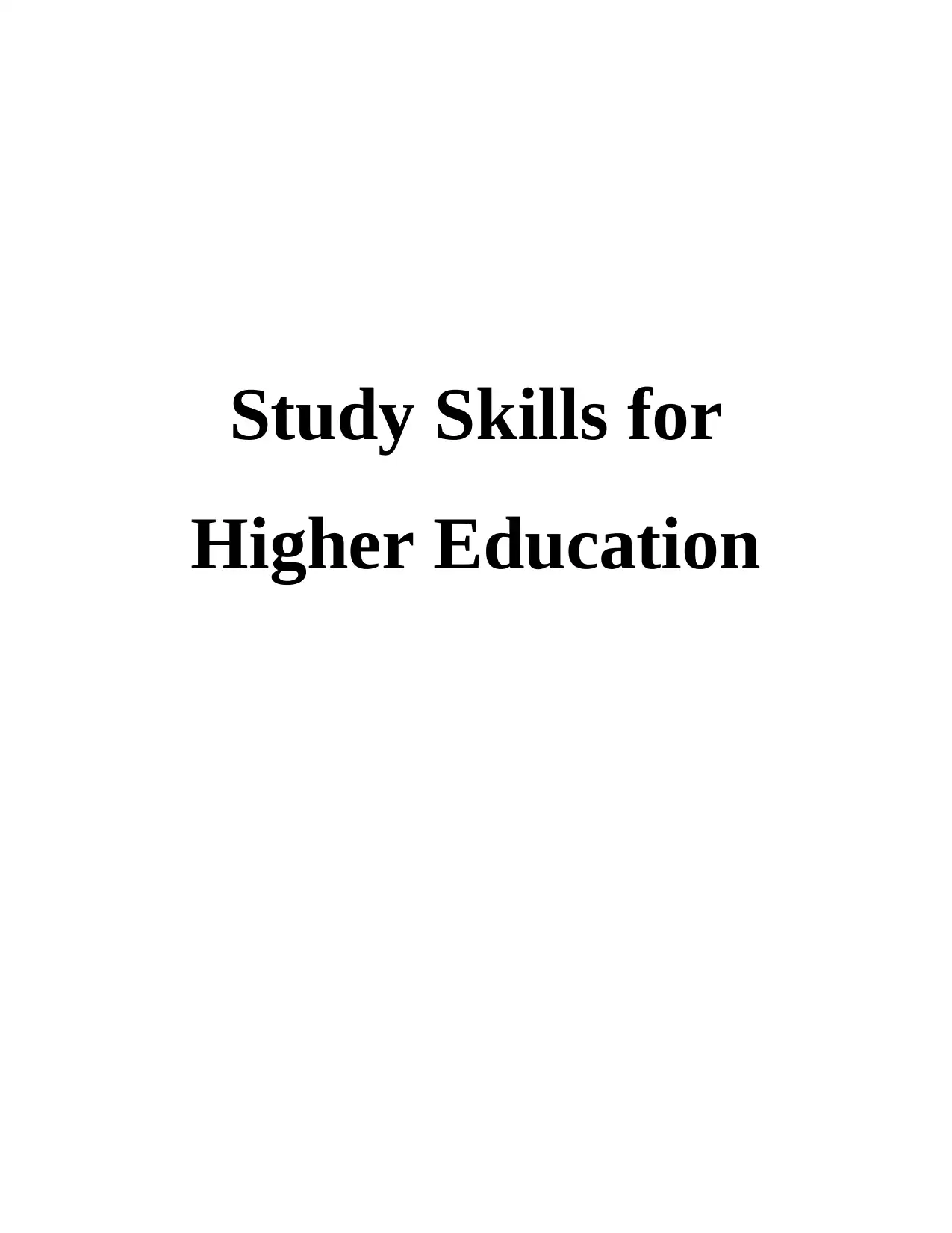
Study Skills for
Higher Education
Higher Education
Paraphrase This Document
Need a fresh take? Get an instant paraphrase of this document with our AI Paraphraser
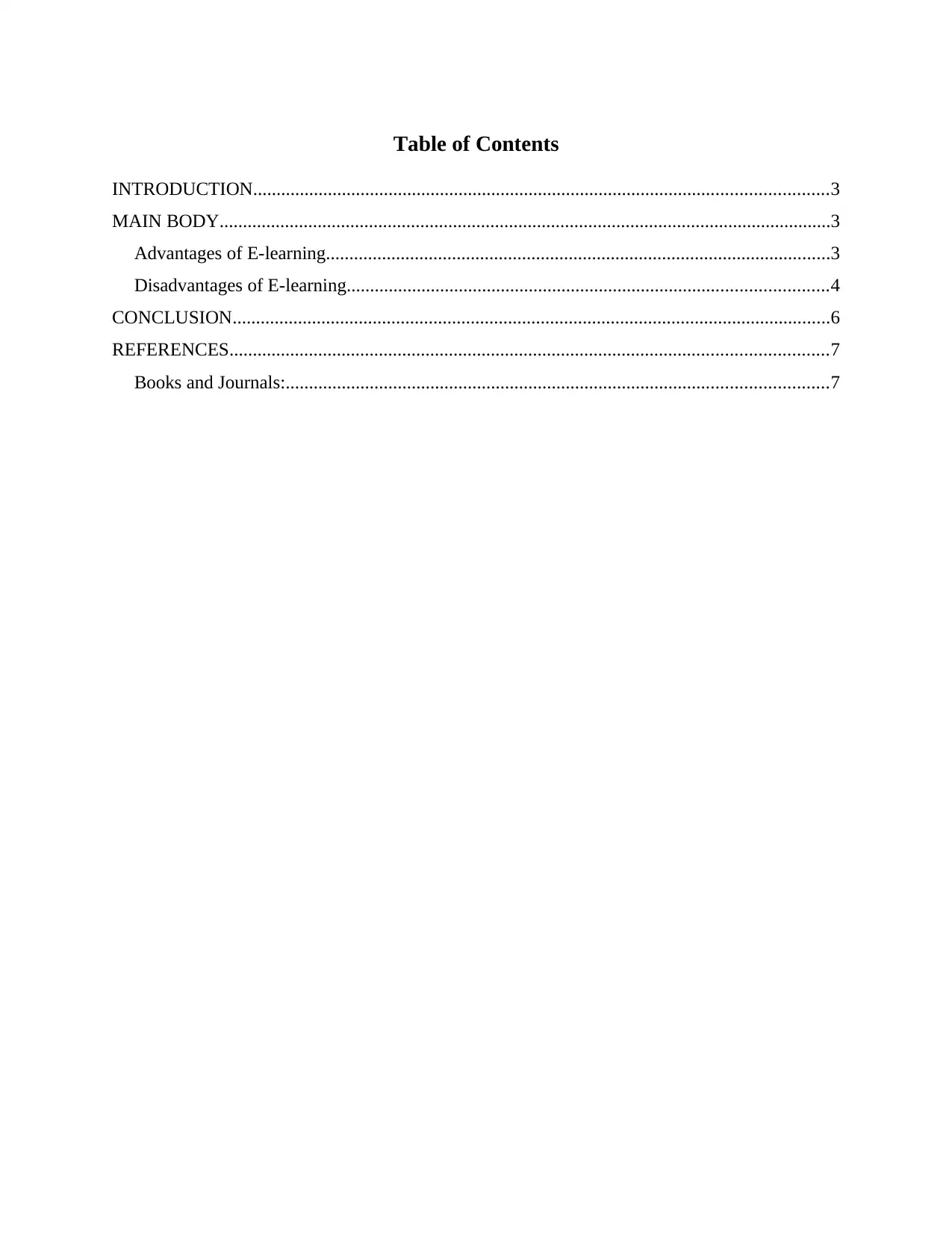
Table of Contents
INTRODUCTION...........................................................................................................................3
MAIN BODY...................................................................................................................................3
Advantages of E-learning............................................................................................................3
Disadvantages of E-learning.......................................................................................................4
CONCLUSION................................................................................................................................6
REFERENCES................................................................................................................................7
Books and Journals:....................................................................................................................7
INTRODUCTION...........................................................................................................................3
MAIN BODY...................................................................................................................................3
Advantages of E-learning............................................................................................................3
Disadvantages of E-learning.......................................................................................................4
CONCLUSION................................................................................................................................6
REFERENCES................................................................................................................................7
Books and Journals:....................................................................................................................7
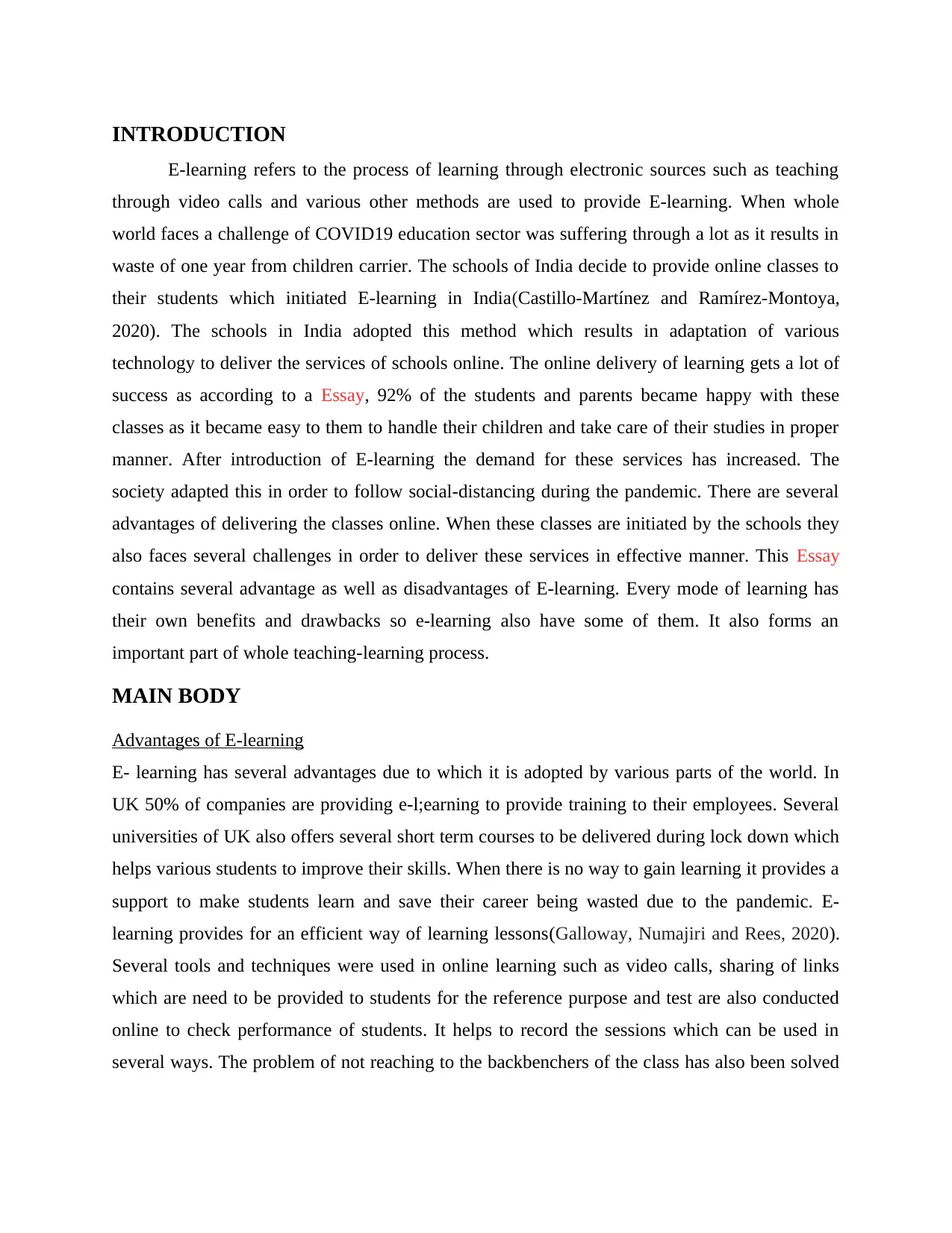
INTRODUCTION
E-learning refers to the process of learning through electronic sources such as teaching
through video calls and various other methods are used to provide E-learning. When whole
world faces a challenge of COVID19 education sector was suffering through a lot as it results in
waste of one year from children carrier. The schools of India decide to provide online classes to
their students which initiated E-learning in India(Castillo-Martínez and Ramírez-Montoya,
2020). The schools in India adopted this method which results in adaptation of various
technology to deliver the services of schools online. The online delivery of learning gets a lot of
success as according to a Essay, 92% of the students and parents became happy with these
classes as it became easy to them to handle their children and take care of their studies in proper
manner. After introduction of E-learning the demand for these services has increased. The
society adapted this in order to follow social-distancing during the pandemic. There are several
advantages of delivering the classes online. When these classes are initiated by the schools they
also faces several challenges in order to deliver these services in effective manner. This Essay
contains several advantage as well as disadvantages of E-learning. Every mode of learning has
their own benefits and drawbacks so e-learning also have some of them. It also forms an
important part of whole teaching-learning process.
MAIN BODY
Advantages of E-learning
E- learning has several advantages due to which it is adopted by various parts of the world. In
UK 50% of companies are providing e-l;earning to provide training to their employees. Several
universities of UK also offers several short term courses to be delivered during lock down which
helps various students to improve their skills. When there is no way to gain learning it provides a
support to make students learn and save their career being wasted due to the pandemic. E-
learning provides for an efficient way of learning lessons(Galloway, Numajiri and Rees, 2020).
Several tools and techniques were used in online learning such as video calls, sharing of links
which are need to be provided to students for the reference purpose and test are also conducted
online to check performance of students. It helps to record the sessions which can be used in
several ways. The problem of not reaching to the backbenchers of the class has also been solved
E-learning refers to the process of learning through electronic sources such as teaching
through video calls and various other methods are used to provide E-learning. When whole
world faces a challenge of COVID19 education sector was suffering through a lot as it results in
waste of one year from children carrier. The schools of India decide to provide online classes to
their students which initiated E-learning in India(Castillo-Martínez and Ramírez-Montoya,
2020). The schools in India adopted this method which results in adaptation of various
technology to deliver the services of schools online. The online delivery of learning gets a lot of
success as according to a Essay, 92% of the students and parents became happy with these
classes as it became easy to them to handle their children and take care of their studies in proper
manner. After introduction of E-learning the demand for these services has increased. The
society adapted this in order to follow social-distancing during the pandemic. There are several
advantages of delivering the classes online. When these classes are initiated by the schools they
also faces several challenges in order to deliver these services in effective manner. This Essay
contains several advantage as well as disadvantages of E-learning. Every mode of learning has
their own benefits and drawbacks so e-learning also have some of them. It also forms an
important part of whole teaching-learning process.
MAIN BODY
Advantages of E-learning
E- learning has several advantages due to which it is adopted by various parts of the world. In
UK 50% of companies are providing e-l;earning to provide training to their employees. Several
universities of UK also offers several short term courses to be delivered during lock down which
helps various students to improve their skills. When there is no way to gain learning it provides a
support to make students learn and save their career being wasted due to the pandemic. E-
learning provides for an efficient way of learning lessons(Galloway, Numajiri and Rees, 2020).
Several tools and techniques were used in online learning such as video calls, sharing of links
which are need to be provided to students for the reference purpose and test are also conducted
online to check performance of students. It helps to record the sessions which can be used in
several ways. The problem of not reaching to the backbenchers of the class has also been solved
⊘ This is a preview!⊘
Do you want full access?
Subscribe today to unlock all pages.

Trusted by 1+ million students worldwide
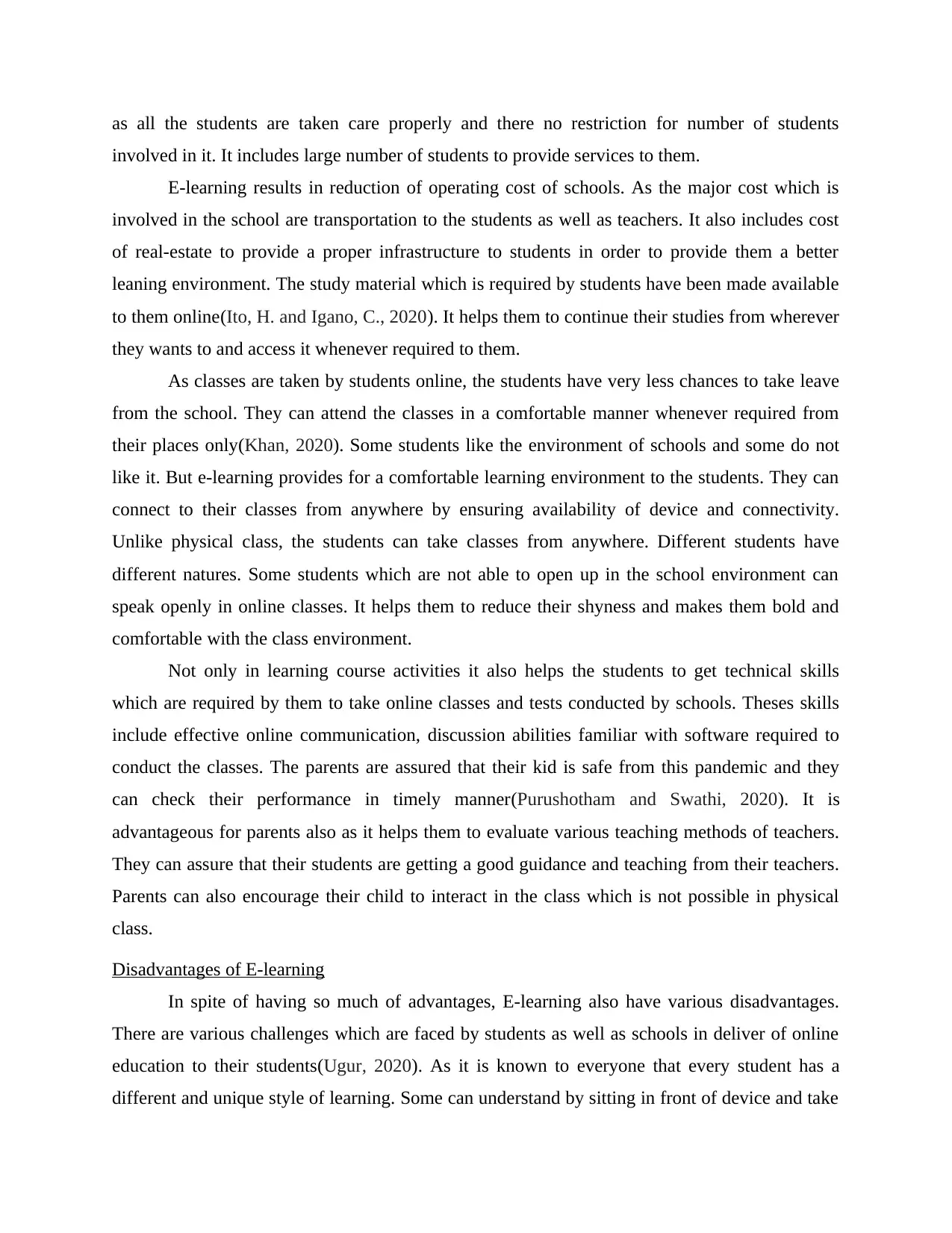
as all the students are taken care properly and there no restriction for number of students
involved in it. It includes large number of students to provide services to them.
E-learning results in reduction of operating cost of schools. As the major cost which is
involved in the school are transportation to the students as well as teachers. It also includes cost
of real-estate to provide a proper infrastructure to students in order to provide them a better
leaning environment. The study material which is required by students have been made available
to them online(Ito, H. and Igano, C., 2020). It helps them to continue their studies from wherever
they wants to and access it whenever required to them.
As classes are taken by students online, the students have very less chances to take leave
from the school. They can attend the classes in a comfortable manner whenever required from
their places only(Khan, 2020). Some students like the environment of schools and some do not
like it. But e-learning provides for a comfortable learning environment to the students. They can
connect to their classes from anywhere by ensuring availability of device and connectivity.
Unlike physical class, the students can take classes from anywhere. Different students have
different natures. Some students which are not able to open up in the school environment can
speak openly in online classes. It helps them to reduce their shyness and makes them bold and
comfortable with the class environment.
Not only in learning course activities it also helps the students to get technical skills
which are required by them to take online classes and tests conducted by schools. Theses skills
include effective online communication, discussion abilities familiar with software required to
conduct the classes. The parents are assured that their kid is safe from this pandemic and they
can check their performance in timely manner(Purushotham and Swathi, 2020). It is
advantageous for parents also as it helps them to evaluate various teaching methods of teachers.
They can assure that their students are getting a good guidance and teaching from their teachers.
Parents can also encourage their child to interact in the class which is not possible in physical
class.
Disadvantages of E-learning
In spite of having so much of advantages, E-learning also have various disadvantages.
There are various challenges which are faced by students as well as schools in deliver of online
education to their students(Ugur, 2020). As it is known to everyone that every student has a
different and unique style of learning. Some can understand by sitting in front of device and take
involved in it. It includes large number of students to provide services to them.
E-learning results in reduction of operating cost of schools. As the major cost which is
involved in the school are transportation to the students as well as teachers. It also includes cost
of real-estate to provide a proper infrastructure to students in order to provide them a better
leaning environment. The study material which is required by students have been made available
to them online(Ito, H. and Igano, C., 2020). It helps them to continue their studies from wherever
they wants to and access it whenever required to them.
As classes are taken by students online, the students have very less chances to take leave
from the school. They can attend the classes in a comfortable manner whenever required from
their places only(Khan, 2020). Some students like the environment of schools and some do not
like it. But e-learning provides for a comfortable learning environment to the students. They can
connect to their classes from anywhere by ensuring availability of device and connectivity.
Unlike physical class, the students can take classes from anywhere. Different students have
different natures. Some students which are not able to open up in the school environment can
speak openly in online classes. It helps them to reduce their shyness and makes them bold and
comfortable with the class environment.
Not only in learning course activities it also helps the students to get technical skills
which are required by them to take online classes and tests conducted by schools. Theses skills
include effective online communication, discussion abilities familiar with software required to
conduct the classes. The parents are assured that their kid is safe from this pandemic and they
can check their performance in timely manner(Purushotham and Swathi, 2020). It is
advantageous for parents also as it helps them to evaluate various teaching methods of teachers.
They can assure that their students are getting a good guidance and teaching from their teachers.
Parents can also encourage their child to interact in the class which is not possible in physical
class.
Disadvantages of E-learning
In spite of having so much of advantages, E-learning also have various disadvantages.
There are various challenges which are faced by students as well as schools in deliver of online
education to their students(Ugur, 2020). As it is known to everyone that every student has a
different and unique style of learning. Some can understand by sitting in front of device and take
Paraphrase This Document
Need a fresh take? Get an instant paraphrase of this document with our AI Paraphraser
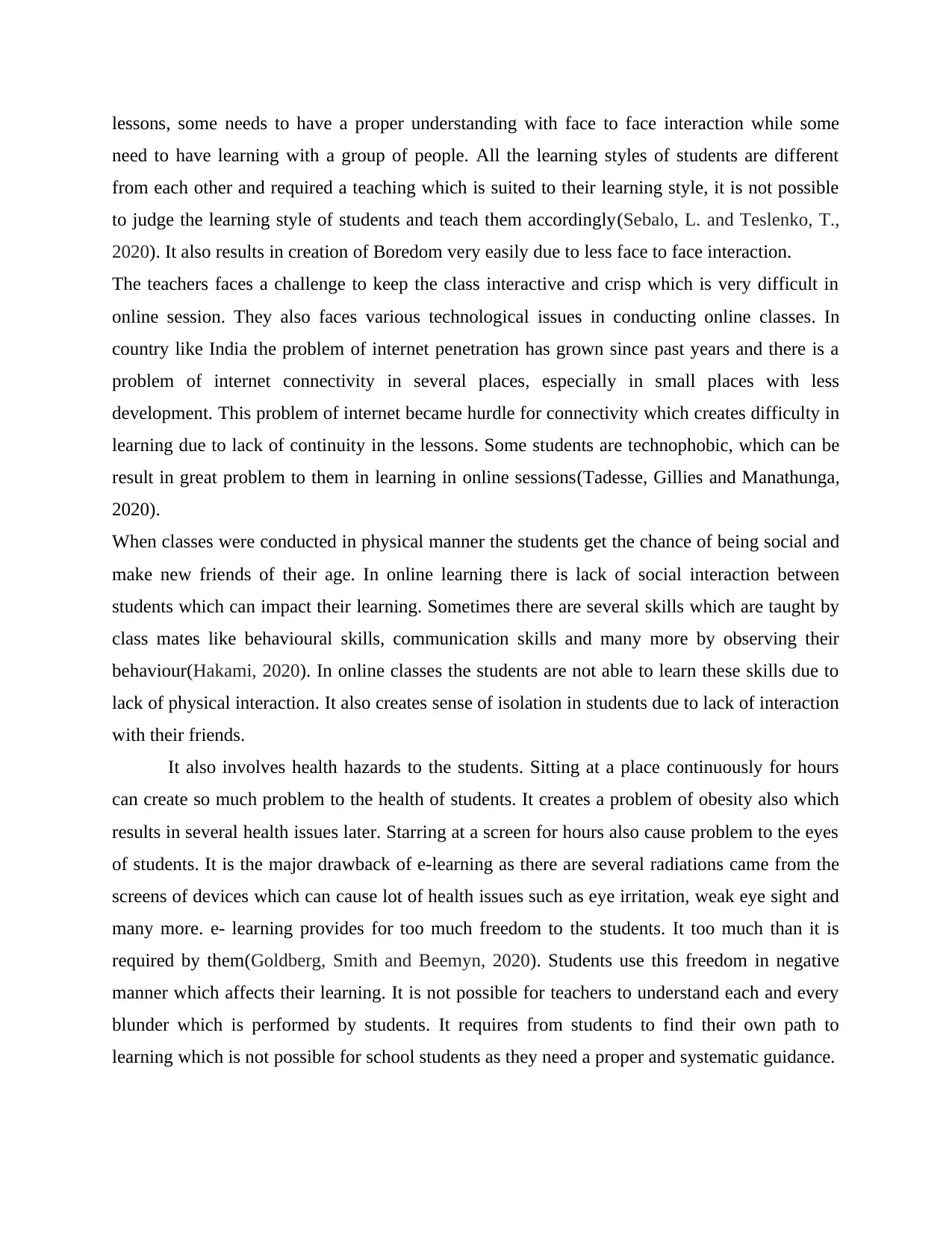
lessons, some needs to have a proper understanding with face to face interaction while some
need to have learning with a group of people. All the learning styles of students are different
from each other and required a teaching which is suited to their learning style, it is not possible
to judge the learning style of students and teach them accordingly(Sebalo, L. and Teslenko, T.,
2020). It also results in creation of Boredom very easily due to less face to face interaction.
The teachers faces a challenge to keep the class interactive and crisp which is very difficult in
online session. They also faces various technological issues in conducting online classes. In
country like India the problem of internet penetration has grown since past years and there is a
problem of internet connectivity in several places, especially in small places with less
development. This problem of internet became hurdle for connectivity which creates difficulty in
learning due to lack of continuity in the lessons. Some students are technophobic, which can be
result in great problem to them in learning in online sessions(Tadesse, Gillies and Manathunga,
2020).
When classes were conducted in physical manner the students get the chance of being social and
make new friends of their age. In online learning there is lack of social interaction between
students which can impact their learning. Sometimes there are several skills which are taught by
class mates like behavioural skills, communication skills and many more by observing their
behaviour(Hakami, 2020). In online classes the students are not able to learn these skills due to
lack of physical interaction. It also creates sense of isolation in students due to lack of interaction
with their friends.
It also involves health hazards to the students. Sitting at a place continuously for hours
can create so much problem to the health of students. It creates a problem of obesity also which
results in several health issues later. Starring at a screen for hours also cause problem to the eyes
of students. It is the major drawback of e-learning as there are several radiations came from the
screens of devices which can cause lot of health issues such as eye irritation, weak eye sight and
many more. e- learning provides for too much freedom to the students. It too much than it is
required by them(Goldberg, Smith and Beemyn, 2020). Students use this freedom in negative
manner which affects their learning. It is not possible for teachers to understand each and every
blunder which is performed by students. It requires from students to find their own path to
learning which is not possible for school students as they need a proper and systematic guidance.
need to have learning with a group of people. All the learning styles of students are different
from each other and required a teaching which is suited to their learning style, it is not possible
to judge the learning style of students and teach them accordingly(Sebalo, L. and Teslenko, T.,
2020). It also results in creation of Boredom very easily due to less face to face interaction.
The teachers faces a challenge to keep the class interactive and crisp which is very difficult in
online session. They also faces various technological issues in conducting online classes. In
country like India the problem of internet penetration has grown since past years and there is a
problem of internet connectivity in several places, especially in small places with less
development. This problem of internet became hurdle for connectivity which creates difficulty in
learning due to lack of continuity in the lessons. Some students are technophobic, which can be
result in great problem to them in learning in online sessions(Tadesse, Gillies and Manathunga,
2020).
When classes were conducted in physical manner the students get the chance of being social and
make new friends of their age. In online learning there is lack of social interaction between
students which can impact their learning. Sometimes there are several skills which are taught by
class mates like behavioural skills, communication skills and many more by observing their
behaviour(Hakami, 2020). In online classes the students are not able to learn these skills due to
lack of physical interaction. It also creates sense of isolation in students due to lack of interaction
with their friends.
It also involves health hazards to the students. Sitting at a place continuously for hours
can create so much problem to the health of students. It creates a problem of obesity also which
results in several health issues later. Starring at a screen for hours also cause problem to the eyes
of students. It is the major drawback of e-learning as there are several radiations came from the
screens of devices which can cause lot of health issues such as eye irritation, weak eye sight and
many more. e- learning provides for too much freedom to the students. It too much than it is
required by them(Goldberg, Smith and Beemyn, 2020). Students use this freedom in negative
manner which affects their learning. It is not possible for teachers to understand each and every
blunder which is performed by students. It requires from students to find their own path to
learning which is not possible for school students as they need a proper and systematic guidance.
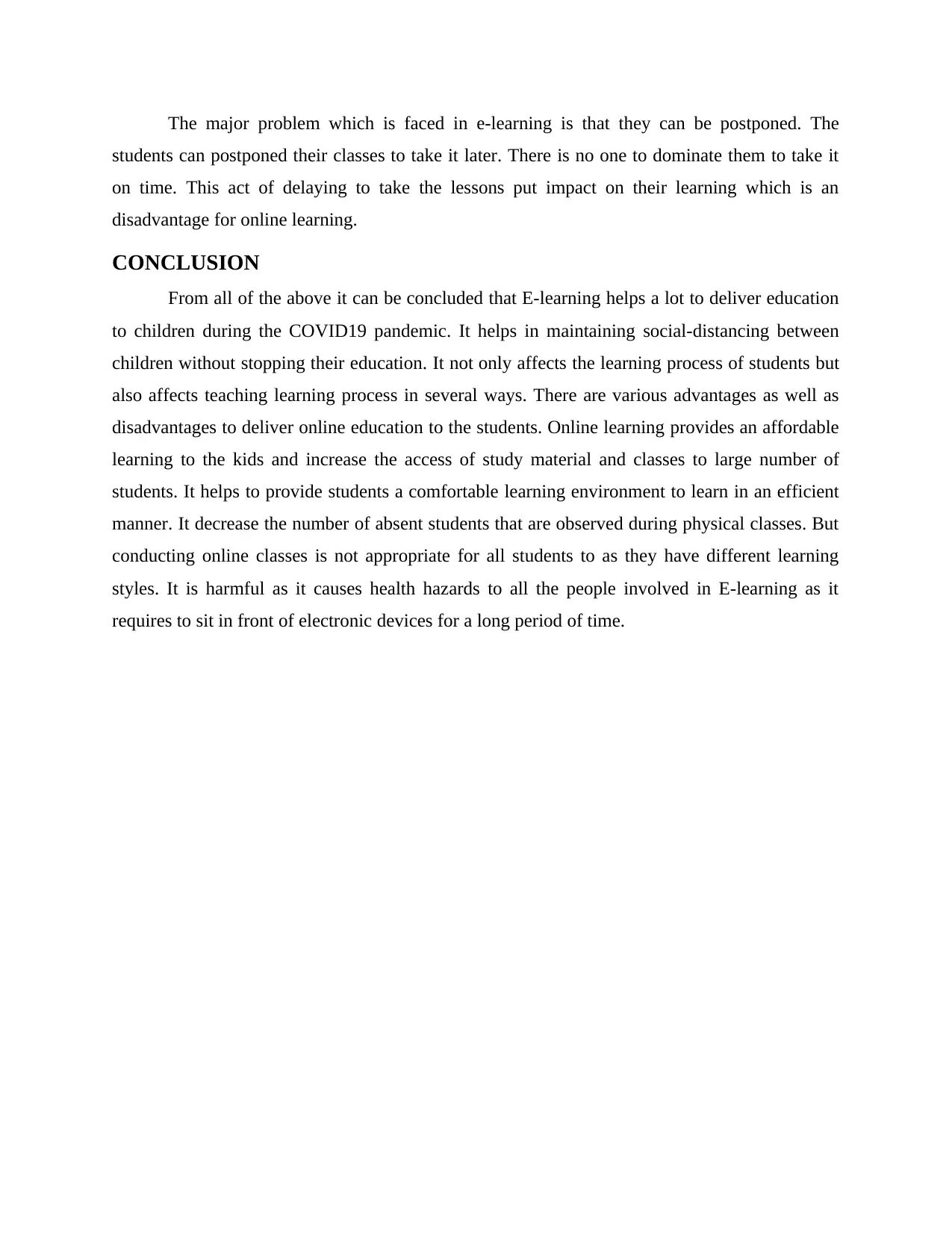
The major problem which is faced in e-learning is that they can be postponed. The
students can postponed their classes to take it later. There is no one to dominate them to take it
on time. This act of delaying to take the lessons put impact on their learning which is an
disadvantage for online learning.
CONCLUSION
From all of the above it can be concluded that E-learning helps a lot to deliver education
to children during the COVID19 pandemic. It helps in maintaining social-distancing between
children without stopping their education. It not only affects the learning process of students but
also affects teaching learning process in several ways. There are various advantages as well as
disadvantages to deliver online education to the students. Online learning provides an affordable
learning to the kids and increase the access of study material and classes to large number of
students. It helps to provide students a comfortable learning environment to learn in an efficient
manner. It decrease the number of absent students that are observed during physical classes. But
conducting online classes is not appropriate for all students to as they have different learning
styles. It is harmful as it causes health hazards to all the people involved in E-learning as it
requires to sit in front of electronic devices for a long period of time.
students can postponed their classes to take it later. There is no one to dominate them to take it
on time. This act of delaying to take the lessons put impact on their learning which is an
disadvantage for online learning.
CONCLUSION
From all of the above it can be concluded that E-learning helps a lot to deliver education
to children during the COVID19 pandemic. It helps in maintaining social-distancing between
children without stopping their education. It not only affects the learning process of students but
also affects teaching learning process in several ways. There are various advantages as well as
disadvantages to deliver online education to the students. Online learning provides an affordable
learning to the kids and increase the access of study material and classes to large number of
students. It helps to provide students a comfortable learning environment to learn in an efficient
manner. It decrease the number of absent students that are observed during physical classes. But
conducting online classes is not appropriate for all students to as they have different learning
styles. It is harmful as it causes health hazards to all the people involved in E-learning as it
requires to sit in front of electronic devices for a long period of time.
⊘ This is a preview!⊘
Do you want full access?
Subscribe today to unlock all pages.

Trusted by 1+ million students worldwide
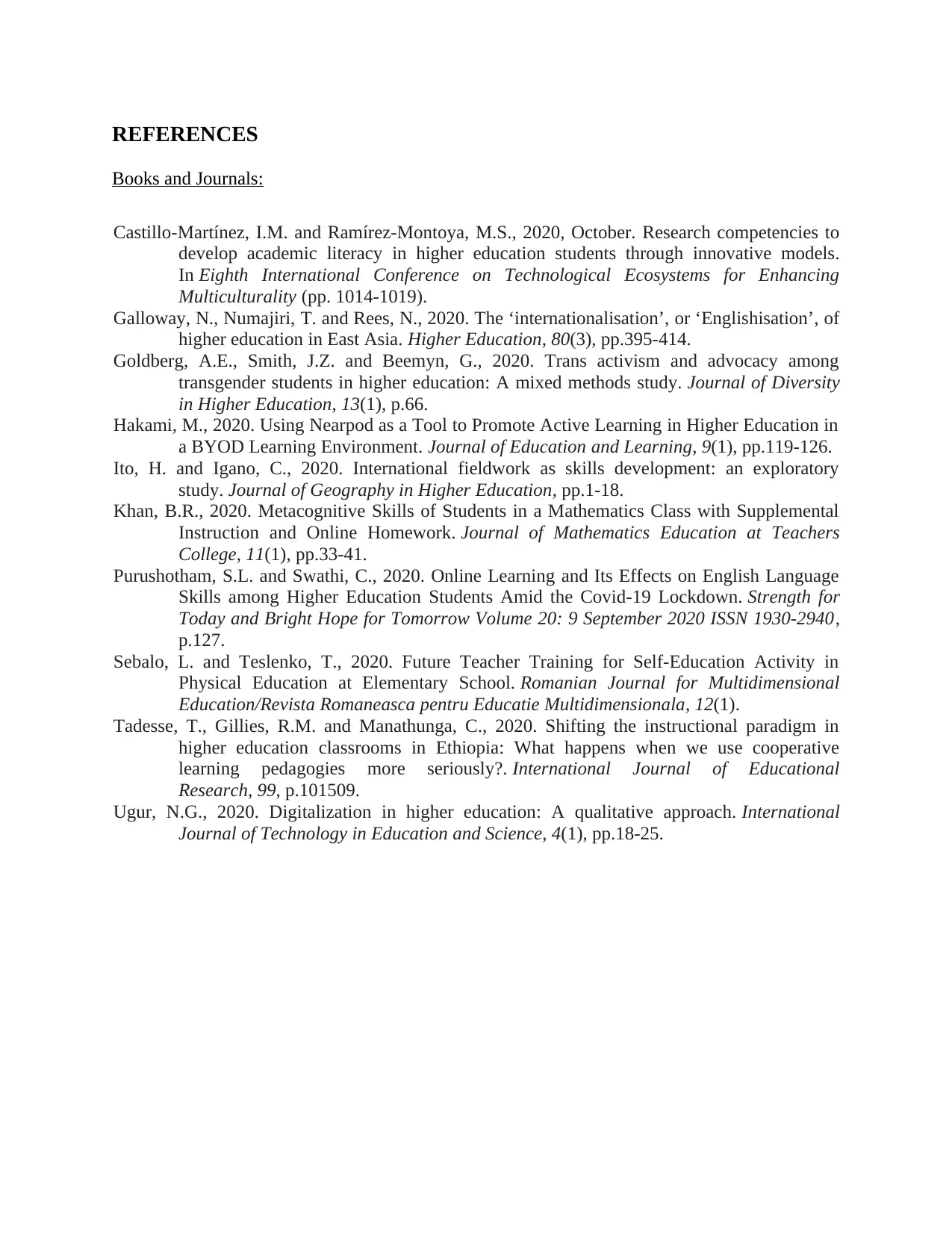
REFERENCES
Books and Journals:
Castillo-Martínez, I.M. and Ramírez-Montoya, M.S., 2020, October. Research competencies to
develop academic literacy in higher education students through innovative models.
In Eighth International Conference on Technological Ecosystems for Enhancing
Multiculturality (pp. 1014-1019).
Galloway, N., Numajiri, T. and Rees, N., 2020. The ‘internationalisation’, or ‘Englishisation’, of
higher education in East Asia. Higher Education, 80(3), pp.395-414.
Goldberg, A.E., Smith, J.Z. and Beemyn, G., 2020. Trans activism and advocacy among
transgender students in higher education: A mixed methods study. Journal of Diversity
in Higher Education, 13(1), p.66.
Hakami, M., 2020. Using Nearpod as a Tool to Promote Active Learning in Higher Education in
a BYOD Learning Environment. Journal of Education and Learning, 9(1), pp.119-126.
Ito, H. and Igano, C., 2020. International fieldwork as skills development: an exploratory
study. Journal of Geography in Higher Education, pp.1-18.
Khan, B.R., 2020. Metacognitive Skills of Students in a Mathematics Class with Supplemental
Instruction and Online Homework. Journal of Mathematics Education at Teachers
College, 11(1), pp.33-41.
Purushotham, S.L. and Swathi, C., 2020. Online Learning and Its Effects on English Language
Skills among Higher Education Students Amid the Covid-19 Lockdown. Strength for
Today and Bright Hope for Tomorrow Volume 20: 9 September 2020 ISSN 1930-2940,
p.127.
Sebalo, L. and Teslenko, T., 2020. Future Teacher Training for Self-Education Activity in
Physical Education at Elementary School. Romanian Journal for Multidimensional
Education/Revista Romaneasca pentru Educatie Multidimensionala, 12(1).
Tadesse, T., Gillies, R.M. and Manathunga, C., 2020. Shifting the instructional paradigm in
higher education classrooms in Ethiopia: What happens when we use cooperative
learning pedagogies more seriously?. International Journal of Educational
Research, 99, p.101509.
Ugur, N.G., 2020. Digitalization in higher education: A qualitative approach. International
Journal of Technology in Education and Science, 4(1), pp.18-25.
Books and Journals:
Castillo-Martínez, I.M. and Ramírez-Montoya, M.S., 2020, October. Research competencies to
develop academic literacy in higher education students through innovative models.
In Eighth International Conference on Technological Ecosystems for Enhancing
Multiculturality (pp. 1014-1019).
Galloway, N., Numajiri, T. and Rees, N., 2020. The ‘internationalisation’, or ‘Englishisation’, of
higher education in East Asia. Higher Education, 80(3), pp.395-414.
Goldberg, A.E., Smith, J.Z. and Beemyn, G., 2020. Trans activism and advocacy among
transgender students in higher education: A mixed methods study. Journal of Diversity
in Higher Education, 13(1), p.66.
Hakami, M., 2020. Using Nearpod as a Tool to Promote Active Learning in Higher Education in
a BYOD Learning Environment. Journal of Education and Learning, 9(1), pp.119-126.
Ito, H. and Igano, C., 2020. International fieldwork as skills development: an exploratory
study. Journal of Geography in Higher Education, pp.1-18.
Khan, B.R., 2020. Metacognitive Skills of Students in a Mathematics Class with Supplemental
Instruction and Online Homework. Journal of Mathematics Education at Teachers
College, 11(1), pp.33-41.
Purushotham, S.L. and Swathi, C., 2020. Online Learning and Its Effects on English Language
Skills among Higher Education Students Amid the Covid-19 Lockdown. Strength for
Today and Bright Hope for Tomorrow Volume 20: 9 September 2020 ISSN 1930-2940,
p.127.
Sebalo, L. and Teslenko, T., 2020. Future Teacher Training for Self-Education Activity in
Physical Education at Elementary School. Romanian Journal for Multidimensional
Education/Revista Romaneasca pentru Educatie Multidimensionala, 12(1).
Tadesse, T., Gillies, R.M. and Manathunga, C., 2020. Shifting the instructional paradigm in
higher education classrooms in Ethiopia: What happens when we use cooperative
learning pedagogies more seriously?. International Journal of Educational
Research, 99, p.101509.
Ugur, N.G., 2020. Digitalization in higher education: A qualitative approach. International
Journal of Technology in Education and Science, 4(1), pp.18-25.
Paraphrase This Document
Need a fresh take? Get an instant paraphrase of this document with our AI Paraphraser

1 out of 8
Related Documents
Your All-in-One AI-Powered Toolkit for Academic Success.
+13062052269
info@desklib.com
Available 24*7 on WhatsApp / Email
![[object Object]](/_next/static/media/star-bottom.7253800d.svg)
Unlock your academic potential
Copyright © 2020–2025 A2Z Services. All Rights Reserved. Developed and managed by ZUCOL.



